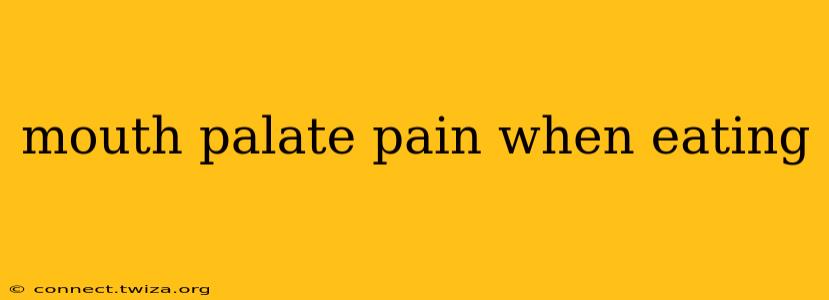Experiencing pain in your mouth and palate while eating can be incredibly frustrating and disruptive. This discomfort can stem from various underlying issues, ranging from minor irritations to more serious medical conditions. Understanding the potential causes is crucial for effective diagnosis and treatment. This comprehensive guide will explore the common culprits behind this painful experience, helping you navigate the path to relief.
What Causes Mouth and Palate Pain When Eating?
The pain you feel in your mouth and palate while eating could originate from several sources. Let's delve into some of the most common:
-
Oral Thrush (Candidiasis): A fungal infection caused by an overgrowth of Candida yeast, oral thrush manifests as white patches on the tongue, mouth, and palate. These patches can be painful and make eating difficult.
-
Mouth Sores (Aphthous Ulcers): These small, painful ulcers frequently appear inside the mouth, including on the palate. Their exact cause is unknown, but stress, hormonal changes, and nutritional deficiencies are suspected triggers.
-
Burning Mouth Syndrome: This chronic condition causes a burning sensation in the mouth, often affecting the tongue, lips, and palate. The cause remains unclear, but it's often linked to hormonal changes, nutritional deficiencies, or nerve damage.
-
Allergies: Food allergies can trigger inflammation and pain in the mouth and palate. Reactions can range from mild discomfort to severe swelling (angioedema).
-
Gingivitis and Periodontitis: Gum disease, in its various stages, can lead to inflammation and pain that extends to the palate. Poor oral hygiene is a significant contributing factor.
-
Dry Mouth (Xerostomia): A lack of saliva can make the mouth and palate feel dry, irritated, and painful, particularly when eating dry or spicy foods. Medications and certain medical conditions can contribute to dry mouth.
-
Oral Cancer: While less common, pain in the mouth and palate, particularly if persistent or accompanied by other symptoms like lumps, bleeding, or difficulty swallowing, could indicate oral cancer. This necessitates immediate medical attention.
-
Trauma: An injury to the mouth or palate, such as from a burn, bite, or dental procedure, can cause significant pain during eating.
What are Some Other Symptoms Associated with Mouth and Palate Pain?
Understanding associated symptoms is vital for accurate diagnosis. These might include:
- Difficulty swallowing (dysphagia): This indicates a more serious underlying issue.
- Changes in taste: Alterations in your ability to taste food.
- White or red patches in the mouth: Suggestive of fungal infections or other conditions.
- Fever and fatigue: Potentially indicative of an infection.
- Swelling in the mouth or face: Could signal an allergic reaction.
How is Mouth and Palate Pain Diagnosed?
Your dentist or doctor will likely conduct a thorough oral examination, reviewing your medical history and asking about your symptoms. Diagnostic tests might include:
- Blood tests: To check for infections, allergies, or nutritional deficiencies.
- Biopsy: A small tissue sample might be taken to rule out oral cancer.
- Imaging tests (X-rays, CT scans): To investigate underlying structural issues.
What Treatments are Available for Mouth and Palate Pain?
Treatment depends heavily on the underlying cause. Possible options include:
- Antifungal medications: For oral thrush.
- Pain relievers (over-the-counter or prescription): To manage pain and inflammation.
- Steroid creams or rinses: To reduce inflammation.
- Antihistamines: For allergic reactions.
- Saliva substitutes: For dry mouth.
- Dietary changes: Avoiding triggering foods or improving nutrition.
- Surgery: In cases of severe trauma or other underlying conditions.
When Should I Seek Medical Attention?
Seek immediate medical attention if you experience:
- Severe or persistent pain.
- Difficulty swallowing.
- Unexplained bleeding in your mouth.
- Lumps or sores that don't heal.
- Swelling in the mouth or face.
This information is intended for educational purposes only and should not be considered medical advice. Always consult with a qualified healthcare professional for diagnosis and treatment of any medical condition. Early intervention is key to managing mouth and palate pain effectively and preventing further complications.
